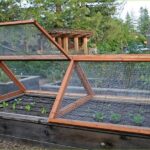Are you interested in growing your own vegetables but don’t have a lot of space? Zone 5 container vegetable gardening may be the perfect solution for you. In this article, we will explore the ins and outs of container gardening in Zone 5, including tips on choosing the right containers, selecting the best vegetables, soil and fertilization requirements, watering and maintenance tips, dealing with pests and diseases, seasonal considerations, and harvesting your bountiful produce.
Zone 5 can present its own set of challenges for gardeners, with a short growing season and cold winter temperatures. However, with the right knowledge and techniques, it is possible to grow a wide variety of vegetables in containers even in this zone. By understanding the specific needs of plants and how to care for them appropriately in containers, you can enjoy a successful vegetable garden no matter how limited your outdoor space may be.
Container gardening is not only practical for those with limited outdoor space; it also offers the flexibility to move plants around to maximize sunlight exposure or protect them from harsh weather conditions. Whether you have a small balcony, patio, or just a few square feet of yard space to work with, Zone 5 container vegetable gardening allows anyone to enjoy the pleasures of growing their own fresh produce.
So let’s dive into everything you need to know to get started.
Choosing the Right Containers for Zone 5 Gardening
When it comes to zone 5 container vegetable gardening, choosing the right containers is crucial for the success of your plants. Here are some factors to consider when selecting containers for your garden:
1. Size: Ensure that the containers you choose are large enough to accommodate the root systems of your chosen vegetables. Consider the mature size of the plants and select containers that provide ample space for growth.
2. Material: Different materials have varying levels of insulation and drainage. For zone 5 container gardening, it’s important to choose materials like plastic, fiberglass, or concrete that can withstand the fluctuating temperatures of the region.
3. Drainage: Proper drainage is essential for container gardening in zone 5. Look for containers with drainage holes at the bottom to prevent waterlogging, which can lead to root rot and other issues.
4. Mobility: Depending on the layout of your garden, you may want to consider the mobility of your containers. Choose options with wheels or lightweight materials if you need to move them around to optimize sunlight exposure.
By taking these factors into account, you can ensure that your chosen containers support healthy growth and productivity for your zone 5 container vegetable gardening endeavors.
Selecting the Best Vegetables for Zone 5 Container Gardening
When it comes to zone 5 container vegetable gardening, selecting the right vegetables is crucial for a successful harvest. Not all vegetables thrive in containers, especially in colder climates like zone 5. To make the most of your limited space and ensure a bountiful harvest, here are some of the best vegetables for zone 5 container gardening:
1. Tomatoes: Ideal for container gardening, tomatoes can be grown in pots with proper support for their vines. Look for compact or dwarf varieties that are well-suited for small spaces.
2. Peppers: Both sweet and hot peppers can be successfully grown in containers in zone 5. Choose smaller varieties that are more suitable for confined spaces.
3. Leafy greens: Vegetables like lettuce, spinach, and kale are perfect for container gardening as they don’t require a lot of space to flourish.
4. Herbs: Many herbs such as basil, cilantro, and mint do well in containers and can be grown alongside other vegetables or on their own.
5. Bush Beans: These compact plants are well-suited for container gardening and are a great choice if you’re looking to grow legumes in limited space.
6. Radishes: Radishes have a quick maturation period and can be easily grown in containers, making them a great option for zone 5 gardeners with limited space.
By choosing the right vegetables for your zone 5 container garden, you can maximize your harvest while enjoying fresh produce all season long.
Remember that while these are some top choices, there are many other vegetables that can thrive in containers with proper care and attention. Experimenting with different types of vegetables will allow you to discover what works best in your specific growing conditions. With careful planning and selection, you can create a diverse and productive container garden even in colder climates like zone 5.
Proper Soil and Fertilization for Zone 5 Container Gardening
When it comes to successful Zone 5 container vegetable gardening, the right soil and proper fertilization are crucial. The limited space in containers means that the soil needs to be able to provide all the necessary nutrients for the vegetables to thrive. Choosing the right soil mixture is key to ensuring healthy and productive vegetable plants.
Soil Mixture
For Zone 5 container gardening, a well-draining soil mixture is essential. A good mix should consist of a combination of peat moss, vermiculite, and compost. This will provide a balanced environment for the roots of the vegetables to grow and absorb nutrients. It’s important to avoid using garden soil in containers as it can become compacted and hinder root growth.
Fertilization
In addition to choosing the right soil mixture, fertilizing your container-grown vegetables is necessary for their healthy development. A slow-release organic fertilizer can be added to the soil mix before planting. Additionally, regular applications of liquid fertilizer throughout the growing season can help ensure that your vegetables have access to the nutrients they need. Be sure to follow the instructions on the fertilizer packaging carefully to avoid over-fertilizing which can harm your plants.
Compost
Using compost in your container gardening is another important aspect of proper soil and fertilization for Zone 5 gardening. It not only provides essential nutrients but also helps improve soil structure and water retention capabilities. Consider mixing compost into your soil at planting time, and as a top dressing during the growing season.
Watering and Maintenance Tips for Successful Zone 5 Container Gardening
Watering Techniques
In Zone 5, where temperatures can fluctuate, it is essential to water your container garden adequately. The frequency of watering will depend on the weather conditions, the size of your containers, and the type of vegetables you are growing. As a general rule, most vegetables need at least an inch of water per week.
However, during hot and dry periods, you may need to water more frequently. Consider using a watering can or drip irrigation system to ensure that your plants receive consistent moisture.
Maintenance Practices
Regular maintenance is crucial for the success of your Zone 5 container vegetable garden. This includes monitoring for any signs of pests or diseases, removing weeds that compete with your vegetables for nutrients, and providing support for plants that may grow tall or heavy with fruits.
Additionally, it is essential to keep an eye out for any nutrient deficiencies in your plants by regularly fertilizing them as needed. Proper pruning and deadheading can also encourage healthier growth and maximum yields from your vegetables.
Protecting From Extreme Temperatures
In Zone 5, where temperatures can vary dramatically throughout the year, it’s important to protect your container garden from extreme heat or cold. During hot summer days, consider providing shade for your plants if they are at risk of wilting or sunburning.
Conversely, in winter months, moving your containers to a sheltered area or wrapping them with insulating materials can help prevent freezing damage to your vegetables. By taking these measures, you can help ensure the health and productivity of your container garden year-round.
By implementing these watering and maintenance tips in your zone 5 container vegetable gardening practices, you can increase the chances of a bountiful harvest while keeping your plants healthy and thriving throughout the growing season.
Dealing With Pests and Diseases in Zone 5 Container Gardening
One of the challenges of zone 5 container vegetable gardening is dealing with pests and diseases that can affect your plants. Pests like aphids, caterpillars, and mealybugs can damage your vegetables, while diseases like powdery mildew and blight can also cause harm. It’s important to regularly inspect your plants for any signs of infestation or disease so you can take action promptly.
There are several methods for dealing with pests and diseases in zone 5 container gardening. One approach is to use companion planting, which involves growing certain plants together to naturally repel pests or attract beneficial insects. For example, planting marigolds near your vegetables can help deter nematodes and other harmful insects. Additionally, using organic insecticidal soaps or neem oil sprays can effectively control many common pests without harming beneficial insects.
In terms of diseases, practicing good sanitation in your garden can help prevent the spread of fungal and bacterial infections. This includes removing any infected plant material, keeping foliage dry by watering at the base of plants, and providing adequate air circulation around your containers. Choosing disease-resistant varieties when selecting vegetables for your zone 5 container garden can also help minimize the risk of infection.
| Pest/Disease Control Method | Effectiveness |
|---|---|
| Companion Planting | Effective for deterring pests and attracting beneficial insects |
| Organic Insecticidal Soaps/Neem Oil Sprays | Control many common pests without harming beneficial insects |
| Good Sanitation Practices | Help prevent the spread of fungal and bacterial infections |
Seasonal Considerations for Zone 5 Container Gardening
Zone 5 container vegetable gardening comes with unique challenges in each season. In the spring, it’s important to start your container garden early, as the growing season is shorter in this zone. Consider starting seeds indoors to get a head start on the growing season. Be sure to protect your young plants from any late frosts by covering them or bringing them inside if necessary.
During the summer months, be mindful of watering your container plants frequently, as the heat can cause them to dry out much faster than plants in traditional gardens. Consider using mulch on top of the soil to help retain moisture and keep your plants healthy. You may also need to provide some shade for your vegetable containers during especially hot days.
As fall approaches, be prepared for cooler temperatures and potential frost. Extend your growing season by using cold frames or row covers to protect your plants from early frosts. You may also want to consider planting cold-hardy vegetables that can withstand lighter frosts, such as kale, carrots, and spinach.
| Season | Tips |
|---|---|
| Spring | Start seeds indoors; protect young plants from late frosts |
| Summer | Water frequently; use mulch; provide shade during hot days |
| Fall | Protect from early frosts; plant cold-hardy vegetables for extended growing season |
Harvesting and Enjoying the Fruits of Your Zone 5 Container Vegetable Gardening Efforts
In conclusion, Zone 5 container vegetable gardening can be a rewarding and enjoyable experience for both novice and experienced gardeners. By following the tips and guidelines provided in this article, anyone living in Zone 5 can successfully grow their own vegetables in containers, even if they don’t have access to a traditional garden space.
When it comes to harvesting the fruits of your labor, remember to pick your vegetables at the peak of ripeness for the best flavor and nutritional value. This may require frequent checking and harvesting as different vegetables ripen at different times, but the bountiful harvest will be well worth the effort.
Lastly, don’t forget to savor all your hard work by incorporating your home-grown produce into delicious meals for you and your loved ones. Whether it’s a fresh salad with crispy lettuce and juicy tomatoes or a hearty stir-fry with an assortment of veggies, enjoying the fruits of your Zone 5 container vegetable gardening efforts will bring satisfaction like no other.
So roll up your sleeves, get your hands dirty, and embrace the joys of growing your own vegetables right in the comfort of your home. Happy gardening.
Frequently Asked Questions
What Vegetables Are Good for Zone 5?
In Zone 5, many vegetables thrive including tomatoes, peppers, carrots, lettuce, spinach, and radishes. Broccoli, kale, and Swiss chard also do well in this zone due to the cooler temperatures.
What Is the Best Vegetable to Grow in a Container?
The best vegetable to grow in a container is determined by the size of the container and the growing conditions. However, some top choices for container gardening include tomatoes, peppers, lettuce, spinach, and herbs like basil and parsley.
How Many Vegetables Can I Grow in a 5 Gallon Container?
In a 5-gallon container, you can typically grow one tomato plant or pepper plant. Alternatively, you can grow a few smaller plants like lettuce or herbs together in one 5-gallon container as long as they have similar growing requirements. Overcrowding should be avoided to ensure healthy growth.

If you’re looking to get into vegetable gardening, or are just looking for some tips on how to make your current garden better, then you’ve come to the right place! My name is Ethel and I have been gardening for years. In this blog, I’m going to share with you some of my best tips on how to create a successful vegetable garden.





